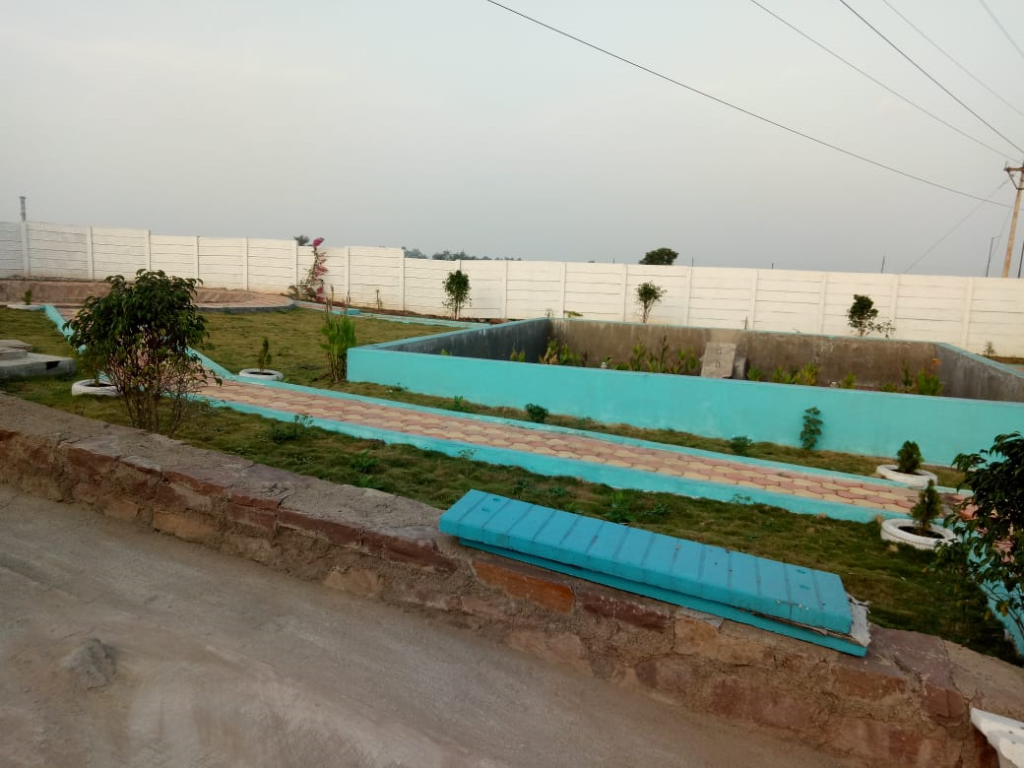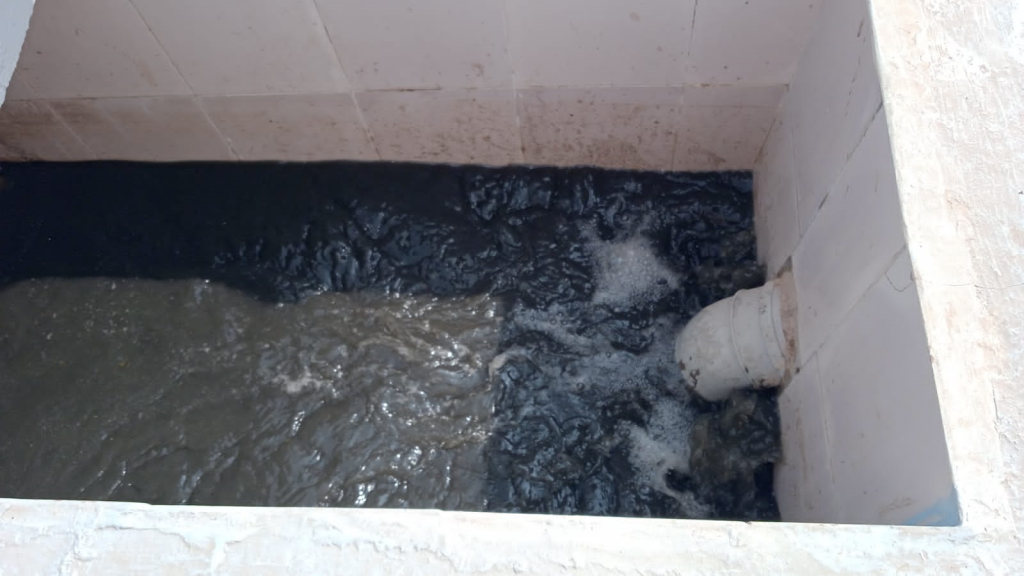
The Faecal Sludge Treatment Plant (FSTP) set up in the peri-urban town of Kumhari in Durg district of Chhattisgarh is a unique example of rural-urban convergence. The plant caters to the town folk as well as the households of six panchayats situated nearby, planned that way from the construction stage.
Having conducted trial runs in the week of 8th November 2021, each module of the plant was be further tested in December 2021, and all indications point to the fact that the plant is working well and can be made operational soon. The main emphasis is on safe collection, transportation and treatment of faecal sludge, the details conveyed to the communities through an awareness campaign.
The model project was constructed in the Kumhari cluster at an estimated cost of Rs 47.78 lakh. Kumhari Nagar Palika Parishad has total around 7516 households and the 6 GPs considered under the Kumhari cluster have a total of about 2074 households out of which around 80 per cent of households are accessible for desludging.
Background: Kumhari Cluster comprises of a total of six Gram Panchayats (GPs) namely Dhaba, Kapsada, Khapri, Murra, Pandhdevri and Sankara and the Kumhari Nagar Palika Parishad.
The cluster has no underground drainage system. On-site sanitation systems containing faecal sludge were being desludged using mechanical equipment such as vacuum pumps and the faecal matter was disposed in the open – an unsafe practice, posing innumerable health and environmental risks.
It is common knowledge that the most preferred form of toilets promoted by the Swachh Bharat Mission Grameen were the twin pit toilets which are easy to construct, cost effective, and able to effectively convert faecal matter into manure. However, some households have opted for the septic tank that requires periodic desludging and treatment. That’s where FSTPs such as the one in Kumhari have a key role to play in treating the faecal sludge as close to the source as possible.



Interventions made by: Water Aid and Consortium for DEWATS Dissemination (CDD) Society, have implemented the faecal sludge treatment plant in Kumhari town which can handle 6 cum of faecal sludge daily to serve the households not having access to underground drainage in the city. The facility would convert the sludge generated from on-site sanitation into safe and reusable products.
The technology involves stabilization and dewatering of sludge in Planted Drying Beds. The percolating water is then treated with DEWATS technology using Anaerobic Filters and Planted Gravel Filter. The by-products such as bio-solids can be reused in agriculture as a soil conditioner and the treated wastewater can be used for irrigation or safely disposed into the ground through percolation.
The well designed, environmentally sustainable method of treatment is low in power consumption, requiring negligible operator intervention and skills. While the bi-products of treated sludge can be re-used, the system also points to the importance of shared infrastructure between GPs and the peri-urban town to reduce costs in terms of shared conveyance systems, co-composting, co-treatment, etc., making the system cost effective.
Awareness building: At the outset, meetings were held with the town panchayat and the Gram Panchayats. Then began an awareness campaign which included discussions with SHGs, sanitation workers and the communities, in addition to distribution of leaflets and pamphlets. Training of sanitation workers and desludging operations were held and linkages established. Standard operation procedures were outlined, and equipment and PPE kits procured. “Manual Scavenging is against the law”, the residents were told.
Transportation: Kumhari ULB has a desludging vehicle having a capacity of 3000 L. The mounted tractor serves the ULB and the nearby villages/GPs, its charges being Rs.1000 per trip and Rs. 1500 per trip outside the administrative boundary of ULB up to a maximum of 10 kms outside the boundary.


Operation and Maintenance: WaterAid officials informed that the O&M is simple as there is no mechanical or electrical equipment used. While the plant equipment and plumbing system needs to be checked every six months, the filter media needs to be changed every 3-4 years. Only when there is a difference in the permissible limit of the effluents, the filter media have to be checked.
Bi-laws: Bi-laws have been set by the Collector for emptying the tank with regulations that are to be strictly followed for operation of the FSTP.
Collection Process: Households usually want to desludge when their pits/septic tanks fill up/backflow or there is a blockage or if there is an unpleasant odour emanating from the toilet or containment unit. Their request for desludging is made at the Kumhari Nagar Palika Parishad office. Thereafter, the driver and the safai karamcharis pick up the service request, along with the mobile number of the customer and seek clarification on the address and type and condition of the containment system.
Desludging process: Access to containment systems is a time-consuming task in the entire operation of desludging, usually taking about 30 minutes to 1 hour in locating and opening an access for desludging. The HH’s keep the manhole open and after the desludging is complete, the broken top cover is left for the HH to fix, who in turn hire a construction worker or usually do it themselves. The entire operation of desludging can take anywhere between 30 minutes to 2 hours depending on the consistency of the faecal sludge. After opening the access cover a crow bar or stick is inserted into the pit/septic tank to understand the thickness of the sludge. If the sludge is thick then water is poured usually through the toilet pan or directly via a drum or a pipe and mixed with the crowbar till it can be pumped out. The pipes used for sucking the faecal sludge are flexible so as to enter the inaccessible portions.
Detailed explanation of Planted Drying Beds Model:
The technology selected for Kumhari FSTP is the Planted Drying Bed (PDB) model. It consists of a screening chamber (for pre-treatment), planted drying beds (for Sludge Stabilisation/Dewatering), Anaerobic filter (AF) and Horizontal Planted Gravel Filter (PGF) (for Liquid Wastewater Treatment) and a Polishing Pond (for Tertiary treatment).
Planted drying beds: The screened faecal sludge is applied on to Planted drying beds (PDBs), also sometimes referred to as planted dewatering beds, vertical-flow constructed wetlands and sludge drying reed beds, which are beds of porous media (e.g. sand and gravel) that are planted with emergent macrophytes. PDBs are loaded with layers of sludge that are subsequently dewatered and stabilized through multiple physical and biological mechanisms. Faecal sludge is repeatedly loaded onto PDBs, with up to 10 cm of faecal sludge per loading where it accumulates for several years depending on the loading rate (loading rate 2-year, gestation period- 4 months), the capacity of the system and mineralization rates. Meanwhile the percolated water is treated separately in DEWATS modules. The volume of sludge on the PDB reduces continuously (through moisture loss and degradation), and the plants maintain porosity in the sludge layer thereby significantly reducing the need for sludge removal compared to unplanted drying beds (which require sludge removal every two to three weeks).
Anaerobic filter (AF) and Planted Gravel Filter (PGF): The percolate from the Plated Drying Bed is further subjected to treatment in Anaerobic Filter (AF). The incoming faecal sludge load has moderately less solids content, therefore it is proposed to provide an AF directly. As wastewater flows through the filter, particles are trapped, and organic matter is decomposed by the biomass that is attached to the filter material. From here the organic load enters into PGF. Organic load entering into the PGF is already within the required effluent (BOD < 30 mg/L) requirement. In order to remove the odour and colour and to enrich the wastewater with oxygen it is necessary to allow the wastewater to pass through aerobic treatment. PGF is made of planted filter materials consisting of graded gravel. The bottom slope is 1% and the flow direction is horizontal. The main plants used in this filter bed are Canna Indica, Reed juncus, Papyrus and Phragmites. The plant selection is mainly based on their ability to grow in wastewater and have their roots spread wide. PGF also aids in reducing the nutrients such as Nitrogen, Phosphorous and potassium present in wastewater.
Polishing pond: The main objective of polishing ponds is to improve the hygienic quality, measured by the concentration of two indicator organisms: helminthes eggs and faecal coliforms (FC). The FC removal is normally the slowest process and for that reason becomes the main design criterion for a polishing pond. The HRT for the polishing pond is up to 2 days. Therefore, required volume for 5 m3 /day outlet of PGF is calculated as around 10 m3. The diameter and depth of PP are 5 and 0.5 m respectively. The treated water (outlet of PP) would be used for landscape application in the plant’s premises, or it can be distributed/sold to nearby farmers.
End products and reuse: The treatment system has two end products namely: Treated water and Bio solids. Biogas generated during the anaerobic digestion is of negligible quantity and hence it is vented out. Tertiary treated water and bio-solids can be used for farmlands nearby.
Road: Roads are a key to facilitating desludging vehicles inside the facility for disposal and also for removal and outbound logistics related to final treated products. The roads are designed to be all weather roads, made of good quality bitumen with stable base.
Operator’s room: Office cum operator’s room is provided with office setup to provide a meeting place for the guests. Facilities include a kitchen, attached toilet and bathroom. It also has a store room attached to keep equipment and material. The wastewater generated from the washroom and kitchen is collected into the septic tank, which is further connected to soak pit.
Sludge storage yard: Sludge storage house is provided to store the dried sludge after it is taken out from the drying beds which is further filled in bags of capacity 50 kg each and is lined up systematically in the storage house for selling to the farmers. This storage house can contain 1800 to 2000 number of such bags of dried sludge.


Excellent case study
LikeLike